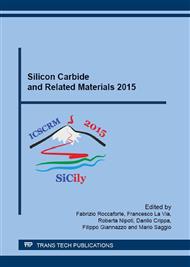p.497
p.501
p.505
p.509
p.513
p.523
p.527
p.531
p.535
A Surprising Result: “Bulk” SiC Defects in the Negative Bias Instability in 4H-SiC MOSFETs
Abstract:
We utilize electrically detected magnetic resonance and “on-the-fly” elevated temperature stressing to examine the effects of negative bias temperature stress on defects within the “bulk” SiC, that is, below the SiC/SiO2 interface. We observe generation of two temperature-dependent defects; one has a two (or three) line spectrum with lines separated by about 61 (30) Gauss when the SiC/SiO2 interface is perpendicular to the magnetic field and very slightly less, about 59 (30) Gauss when the SiC/SiO2 interface is parallel to the field. The second spectrum has a single line with zero-crossing g = 2.0118 when the magnetic field is nearly perpendicular to the SiC/SiO2 interface; the g-value drops to about 2.0016 with the field parallel to the SiC/SiO2 interface. We also observe strong evidence for hydrogen motion within the “bulk” SiC, as both spectra broaden significantly at elevated temperature, with broadening at both high and low fields and frequencies.
Info:
Periodical:
Pages:
513-517
Citation:
Online since:
May 2016
Authors:
Price:
Сopyright:
© 2016 Trans Tech Publications Ltd. All Rights Reserved
Share:
Citation:


